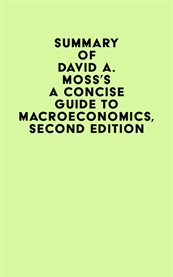Nonfiction
eBook
Details
PUBLISHED
Made available through hoopla
DESCRIPTION
1 online resource
ISBN/ISSN
LANGUAGE
NOTES
Please note: This is a companion version & not the original book. Book Preview: #1 The notion of national output is at the heart of macroeconomics. The total amount of output produced by a country constitutes its ultimate budget constraint. A country can only use more output than it produces if it borrows the difference from foreigners. #2 The most widely used measure of national output is gross domestic product, which is the value of all the goods and services produced in an economy. To avoid counting the same output more than once, it is best to focus on the value added at each stage of production. #3 The expenditure method is the standard approach to calculating GDP. It is the market value of all final goods and services produced within a country over a given year. Government officials typically divide expenditure on final goods and services into five categories: consumption by households, investment in productive assets, government spending on goods and services, exports, and imports. #4 GDP is the total output of a country, and it is measured by focusing on national income. National income is the amount paid to factors of production, labor and capital, for their services
Mode of access: World Wide Web







